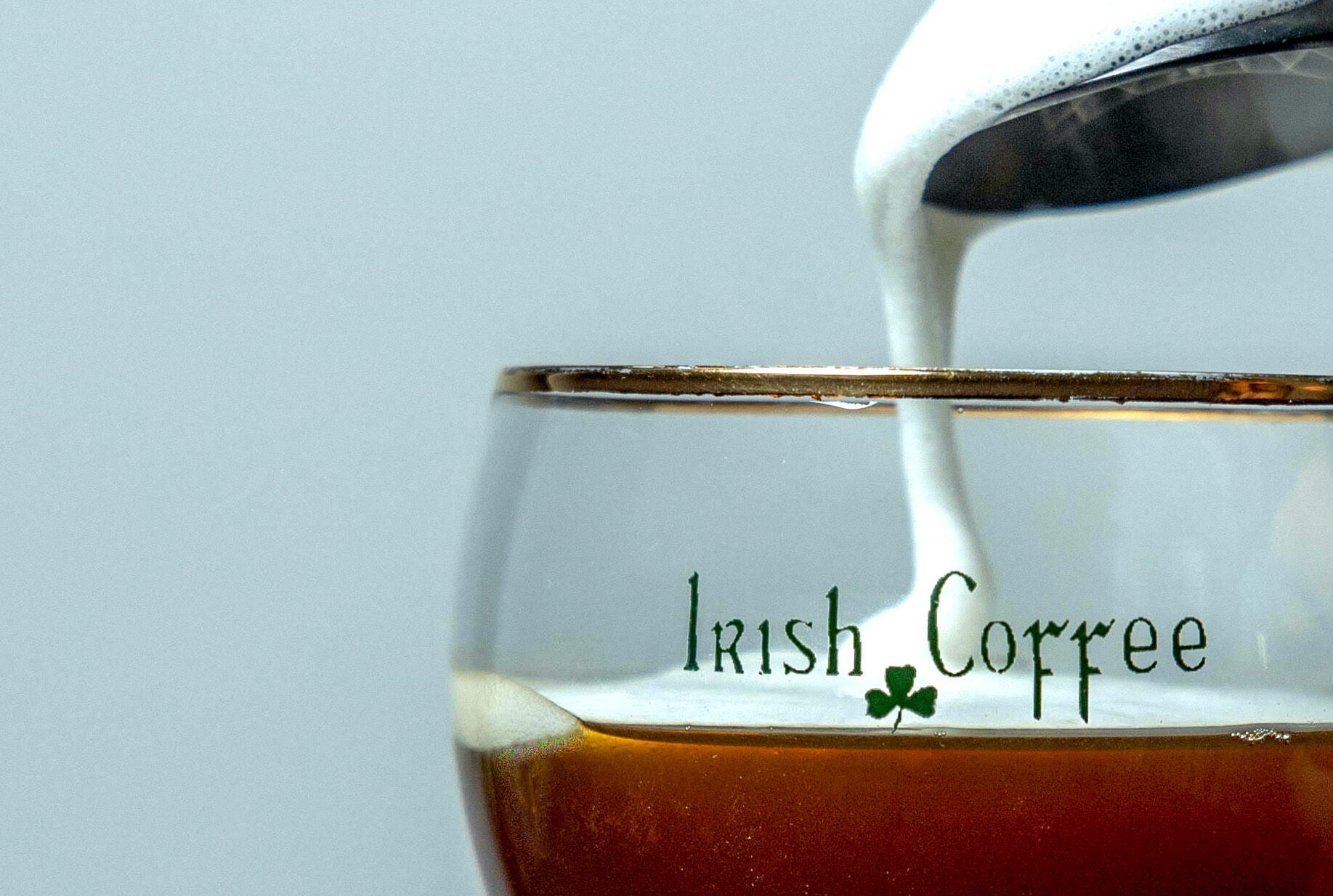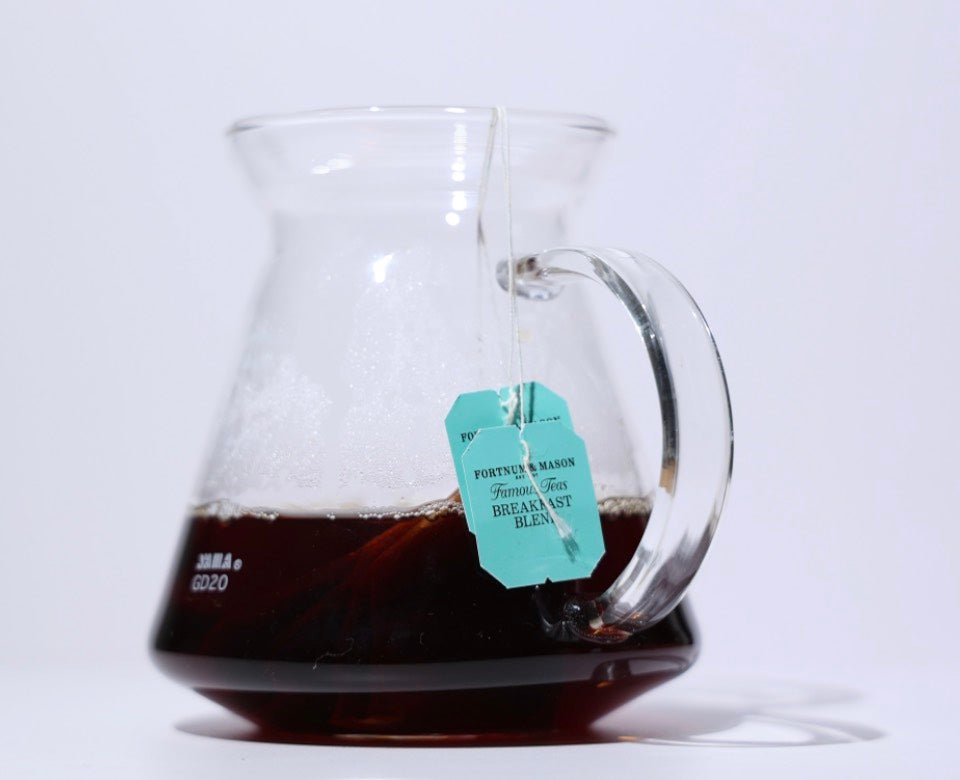
Disappointed by an iconic experience, two coffee experts and coauthors of a new coffee book took matters into their own goblets.
Earlier this month we welcomed But First, Coffee into the world, a new coffee cookbook written by Jordan Michelman (that’s me) and Zachary Carlsen, the cofounders of Sprudge. The book features coffee brewing tips and tricks, a crash primer on making espresso at home, a world of coffee recipes from the kitchen to the bar, and a focus on delicious zero-proof coffee cocktails. There’s one particular drink from this last category that I find myself talking about again and again at book events and podcast tapings: the Zero-Proof Irish Coffee.
Zachary and I have published Sprudge together since 2009, traveling the world for coffee stories along the way. We just so happened to be in San Francisco when the book’s formal contract was signed, some two long years ago, and so we did what any sensible coffee-loving person would do: celebrate with a round of Irish coffees at the Buena Vista, which sits nestled between Fisherman’s Wharf and Ghirardelli Square in a nook of old San Francisco that still looks like a postcard.
This picturesque little café bar lays claim to having popularized and perfected the Irish coffee in 1952, adapting it from a recipe first served at an Irish airport. For the last 75 years they’ve served around 2,000 of them each day (some 40 million in total).
The experience at the Buena Vista sits in that happy spot of the Venn diagram: it is both achingly historic, dripping with earned decades of atmosphere, and still wonderfully good and delicious as an experience in the modern day. This is no museum, and as we settled in among the happy midday crowd at the bar, our minds began ideating as we pondered how we might take our own spin behind the wheel of the great Irish coffee recipe in our forthcoming (and sure to be very popular) new book.
And then the damnedest thing happened.
We ordered two Irish coffees—one classic for me and one zero-proof version for Zachary, who doesn’t drink alcohol. The kindly old bartender looked at us over the top of his black tie and white shirt collar as though there were horns growing out of our heads. “Zero-proof? We don’t get asked for many of those.” But off he went to make it all the same.
This felt like a challenge from the cosmos, a gauntlet laid down, a thunderbolt.
First he whipped up mine, which is to say, one of 20-odd six-ounce goblets of Irish coffee being produced in unison, built together with staggering efficiency and conservation of movement. First a scalding dose of water, then a single sugar cube, then a pour of hot coffee followed by a generous free pour of Tullamore D.E.W. Irish whiskey, and finally a topper of aged, frothed cream to perfectly seal the top of the drink (more on that in a moment). It is ambrosia, a textural symphony of temperatures and flavors, the coffee pulled into a wonderful, puckering molecular tightness by the addition of the whiskey, all of it offset by the cool, thick cream.
Then he made Zachary’s, separate from all the rest. There was water, there was a sugar cube, there was coffee, there was cream. That’s it. “Here you go.”
Now, I should tell you that Zachary felt this was still a delicious cocktail. But you know how people can get on behalf of their friends. I was outraged. You mean to tell me they don’t do anything different at all for the drink? They just omit the whiskey? This seemed like such a missed opportunity. It didn’t taste remotely like an Irish coffee; it tasted like a cup of coffee with some sugar and cream on top—because that’s all it was.
This felt like a challenge from the cosmos, a gauntlet laid down, a thunderbolt. Right then and there, it gave us a sense of purpose for our new book. A celestial dare accepted.
And so we set about trying to create our own zero-proof Irish coffee. There are a few (but surprisingly not many) riffs online, and all of them tend to rely on the use of something like rum extract or bitters in place of whiskey or otherwise sub in a zero-proof whiskey analog. With all due respect to these products, we tried several of them, and nothing quite worked. It also felt kind of lazy to simply swap in a zero-proof whiskey-like substance in place of whiskey.
We could do better. We had to keep searching.

“One day it clicked: let’s substitute oversteeped tea for whiskey in an Irish coffee build.”
As discussed previously in these pages, I am an obsessive tea drinker. Tea’s place in the cocktail world is growing—they’re doing especially thought-provoking stuff at Steep in Los Angeles—and you can find stirring examples of tea and coffee commingling around the world, from spreeze in Ethiopia, to yuenyeung in Hong Kong, to a good old-fashioned “dirty chai” at your favorite Sprudge-esque third-wave café. Some teas even evoke a whiskey-like note, from smoked lapsang souchong to fermented shou pu’er and hei cha.
We drank tea, we thought about Irish coffees, we worked on the cookbook. I am especially allegiant to a mode of tea drinking sometimes referred to as “grandpa-style,” in which one chucks some tea in a large, sturdy mug, then fills that mug up to the top with water and drinks their way through the loose leaves, adding more hot water around halfway. It is a profoundly simple and mellow way to enjoy tea, and it does occasionally result in a kind of “oversteeped” tannic puckering effect, which can be nice, depending on the tea in your mug. (Good for pu’er and oolong, less so for most green teas, in my limited experience.)
One day it clicked: let’s substitute oversteeped tea for whiskey in an Irish coffee build. We tried it out and were blown away by the results. The tea dupes beautifully for the whiskey, creating a tightened, puckery sort of molecular change in the coffee’s mouthfeel, which is really what you would expect from a good Irish coffee. But it’s still smooth, it’s still sweet, and it’s still wonderful to drink with frothed cream. Our Zero-Proof Irish Coffee is a little bit yuenyeung and a little bit grandpa-style, but we’re still playing within the perfect margins of the drink’s spiritual home at the Buena Vista.
It’s a dead-simple build: four ounces of brewed coffee (try Joe Coffee’s The Daily or Yes Plz, both wonderful everyday home drinking blends) with two ounces of oversteeped black tea in place of whiskey—a shou pu’er works great, but so does English breakfast in a pinch (I could drink gallons of Fortnum & Mason’s), or try experimenting with something in the style of a good lapsang souchong. You can go the sugar cube route, but in our book, we recommend instead using a splash of demerara syrup, which is a nod to how they make their Irish coffee at Tom Bergin’s in Los Angeles, another excellent destination for the drink. The trickiest thing about all of it is floating your cream right on the top without it dropping into the coffee below; you need that visual sealing effect for an Irish coffee to be truly right.
This is harder to pull off than it might look. At the Buena Vista, they use a proprietary and, frankly, odd-sounding method of 48-hour aged and frothed cream, which is splashed in a rapid fashion from a metal frothing jug over the back of a bar spoon across a lineup of glass tulips. This trick is part of the magic of the Buena Vista, and gosh, is it delicious, but it’s a touch impractical at home. Tom Bergin’s shakes heavy whipping cream into a plastic squeeze bottle, like what you might use for simple syrup or ketchup, which allows them to carefully top their Irish coffees with cream. This is the method we recommend in our book, although it does help to have a bar spoon at the ready to slow down your pouring. For a nice working example of how to build this drink, we recommend this Irish coffee video from multiple-world-championship-winning UK barista Dan Fellows, who encourages experimentation and riffing.
Something I love the most about this drink is that you don’t need to go and buy something new for it, or pick up a fancy gadget, or add another bottle to your cabinet. Use some tea and some coffee together, hone your method with the cream, and Bob’s your uncle. But if you really want the full effect at home, consider picking up the proper glassware, as perfected by—you guessed it—the Buena Vista in San Francisco. Cheers, and happy drinking.